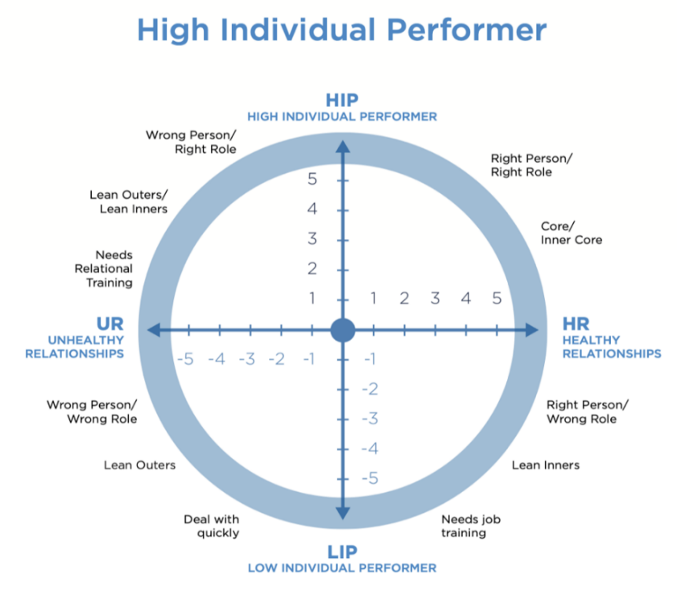We have talked before about the importance and power of relactional leadership, leadership that blends the two-pronged need of building strong relationships in your organization along with the necessity of implementing the vital transactions required to further the organization’s goals. This kind of leadership can help you enhance the performance of your organization as well as improve your relationships. With that kind of relactional leadership in mind, let’s take a moment and assess the current health of your organization.
Assessing and Building Trust
Building trust is one of the main challenges in building high performing teams that have strong personal relationships along with high individual performance. Let’s look at what we’ll call a trust continuum. Some people in your organization will find it more difficult than most to trust you and their coworkers. They are on one end of the trust continuum. These people have very low or no trust until we give them a reason to trust us.
On the other end of this continuum are people who will have a high level of trust and some who will even trust 100% until given a reason not to.
As you look at the trust continuum here, put your initials on the graph where you imagine yourself. Now, put the initials of each person on your team on the continuum.

Where there is low trust, there will be lower overall performance along with unhealthy relationships. Where there is a high level of trust, there will at least be healthy relationships, and if we’ve done a good job of teaching, training, equipping, and putting the people in the right places, we will also have high individual performance.
Assessing Performance and Relationship Health
Now, imagine a team that you are on. Assess the performance levels of each person on your team, including yourself. Place your initials in the spot on this graph below that corresponds with each person on your team. Are they high performers with healthy relationships? High performers with unhealthy relationships? Low performers with healthy relationships? Low performers with unhealthy relationships?

Upper Right-Hand Quadrant
Everyone in the upper right-hand quadrant, your high individual performers and healthy relationships people, would be considered the core of your organization. They are people who have strong relationships and who are high producers. They are positive influencers and become the core and perhaps even the inner core in your organization. I call this area having the right person in the right role.
Lower Right-Hand Quadrant
If you have people in the lower right-hand quadrant, which means they have healthy relationships but low performance, those people need job training. I call this quadrant having the right person in the wrong role. If you put them in roles with responsibilities they can’t fulfill, that’s not their fault. We call them lean-inners because they demonstrate a willingness to be a productive and an effective part of the organization and are supportive of the leadership and the organization’s goals, but they are not currently well-equipped with the right training. However, if you consider sending them for some training to help teach, train, and equip them, you can place them in a role that fits their skills and abilities. Then both they and your organization will thrive, and they can move into the upper right-hand quadrant.
Upper Left-Hand Quadrant
People in the upper left-hand quadrant are high performers with unhealthy relationships. What kind of training do they need? They need relationship training. They may need anger management. You know who they are. Your organization needs this role, but this is the wrong person in that role. These people can include both ones who are supportive and eager to engage in a more productive and healthy way in the organization, people we call the lean-inners, but it can also include people who are negative influencers, people we call the lean-outers. You want to ensure that you help those lean-inners to lean on in to your organization with the right kind of relationship training.
Lower Left-Hand Quadrant
People in the lower left-hand quadrant are low individual performers with unhealthy relationships. I recommend you deal with those people quickly. This is the wrong person in the wrong role. These are the lean-outers, people who can actually sabotage the workings of your organization.
Your Team’s Health
Where are your people on the graph? Where is your team collectively? Wherever the lowest performer and most unhealthy relationship person is, that’s where the team is. If you have one person down in the lower left-hand quadrant, a low performer with unhealthy relationships, this will have a major negative impact on the overall team. The goal is to get everyone on your team into the upper right-hand quadrant.
We can impact our organizations by making sure we have the right people in the right roles. That’s all a part of being a transformational leader. As a transformational leader who wants to build healthy organizations, we can help people improve their relationships and their individual performance by leading effectively and using this tool to gauge the health of our organization.
Ford Taylor is a leadership strategist, keynote speaker, and the author of Relactional Leadership. As the Founder of Transformational Leadership, he is known as a man who can solve complex business issues, with straightforward practical solutions, while maintaining his focus on people.



